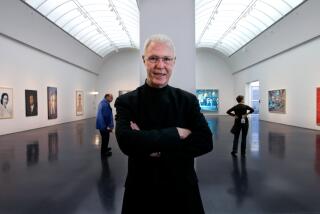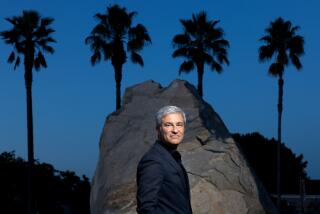Leading Cal Arts From Adolescence to Adulthood : New President Off and Running Toward ‘Next Phase’
- Share via
On Steven Lavine’s second day at CalArts, there are dozens of details to attend to. Meetings, telephone calls and a tour of the basement.
The new president at CalArts hurries through the Valencia school looking like a favorite professor: slightly pudgy in a suit, wire-rimmed glasses and a gap-toothed smile. Talking about his new job, Lavine pauses to recall something about his childhood.
“I used to read in Life and Look magazines about the artists in San Francisco and the beatniks in New York,” the 41-year-old man says. “I idolized artists. They were different and I thought that I could never understand them, so I thought they were better than me.
“CalArts,” he says, “lives the life of the artist.”
Lavine arrived here from the Rockefeller Foundation last week. He comes to this avant-garde college on the edge of Los Angeles at a time when people keep talking about a “next phase” or a “next stage” for the institute.
Something more is expected. More money, even though the school is finally secure after years of financial woes. More presence in Los Angeles, even though both the Los Angeles County Museum of Art and Museum of Contemporary Art are now exhibiting CalArts graduates. More prestige and top-name faculty, even though CalArts has already established a national reputation in the arts.
Lavine speaks in abstract terms when discussing his plans for the college. He says he wants to develop “a new language to discuss the arts” and “change the cultural geography of Los Angeles.”
“I’m sorry,” he says. “I don’t put things in simple sentences. I’ll have to learn to be interviewed better.”
That skill may be important if only because the former president at CalArts, Robert Fitzpatrick, was known for his candor and speaking ability. He forged a dazzling reputation by raising millions of dollars and successfully directing the 1984 Olympic Arts Festival and the 1987 Los Angeles Festival.
Lavine’s work will begin more quietly and closer to home with a part of the institute dear to his heart--the teachers.
“We’re good in all the departments, but we’re not great in all the departments,” he says. “We need to hire new faculty.”
Cautious with his words, Lavine would not single anyone out. The music department will certainly require immediate attention because its dean, Frans van Rossum, left to write a book.
Traditionally, CalArts has pursued artists for teaching positions and Lavine is expanding on this, starting a project to attract faculty members from Asia, Africa and Latin America. His work at the Rockefeller Foundation had a similar intercultural bent and, if nothing else, has won him an important supporter in MOCA Director Richard Koshalek.
“In the city of Los Angeles, with the influx of new populations, this is a major concern of anybody involved in the arts,” Koshalek said. “I think Steven is a brilliant choice. I think the result of his appointment is going to be very important to the city.”
But new faculty and new programs will require more money. It is in this area that Lavine must compete with the legacy of Fitzpatrick, who has moved on to head Euro Disneyland in Paris.
Fitzpatrick came to CalArts in 1975, when the school was on the verge of bankruptcy, and spent the next 13 years raising $27 million in endowments and tripling the annual budget. Chain-smoking, fast-talking and often brutally blunt, he was renowned for his ability to work a room of arts patrons with dynamic pleas for donations.
“I think my personal style is different from Bob’s, but I expect to do the same thing,” Lavine says. “I think the fund raising I’ll be doing is a version of teaching. It’s simply an issue of explaining our case.”
The idea here is that once people know about CalArts, they’ll donate.
“To be honest,” Lavine says, “I don’t think it’s going to be very hard.”
It will, however, be something new for a man who has spent the last seven years giving money away in the form of Rockefeller grants. Lavine will also find himself, for the first time, attempting to manage avant-garde artists--both faculty and students--at a school that prides itself on resisting authority.
Walt Disney paid to build CalArts in the mid-1960s, envisioning a “high-arts sequel to Disneyland.” But “Mickey Mouse U.,” as the school called itself, was quickly mired in controversy. There were allegations of sexual promiscuity and theft. Relations with a conservative board of directors were often tense.
Lavine shrugs off this bit of history. Besides, he says he was probably destined to end up here. There were those years of looking at magazines when he was a kid. Later, in college, Lavine saw the Alain Resnais film “Hiroshima Mon Amour.”
“That was my first art film,” he says. “I didn’t have any idea what it was about, but I was riveted. That was the moment when I knew I had to go away to school, when I knew I had to find the answer.”
Stanford and Harvard provided an education in American literature. Lavine went on to teach English at the University of Michigan, where he created an “18th-Century semester” that offered classes in the arts, music and literature of the era. It was, in some ways, a miniature CalArts.
“He was adventurous and certainly did not settle for the conventional kinds of courses,” said John Knott, the former chairman of Michigan’s English department. “The fact that he would offer that kind of course seemed indicative of creativity and imagination and a desire to reach students.”
At the Rockefeller Foundation, Lavine worked more closely with artists. While at the New York City foundation, he also met his wife, poet and essayist Janet Sternburg.
If there is a personal quest for the new president now that he is at CalArts, it is to explain art to those who don’t understand and combat the institute’s frivolous image.
“This isn’t a kooky place at all,” Lavine says. “I know it looks that way, but it’s just a place full of creative people.”
Among the things that Lavine worries about is CalArts’ annual graduation ceremony. In recent years, graduates have arrived at the podium by helicopter and swinging rope. At one graduation, Fitzpatrick was cut loose in a hot-air balloon that drifted 40 miles before landing in a field.
Lavine spoke at last May’s ceremonies and insists that he enjoyed it. However, he worries about how it appears to outsiders. And after a recent interview, he didn’t want to be photographed in front of a painting in his office that, he said, might look loony to those unfamiliar with art.
“Our students are the ones who go out and have their work shown in local galleries or work in the film industry or dance with Bella Lewitzky,” he says. “But only people deep within the art world of Los Angeles know that.”
If Lavine has to preach this point by driving people out to Valencia to visit the campus, he’ll do that. He wants to send students south in a roving van, to bring their art to the neighborhoods of Los Angeles.
“I’m not an artist,” he says. “That puts me in exactly the right position to demystify this institution, to go out and explain what it is we do here.”
More to Read
The biggest entertainment stories
Get our big stories about Hollywood, film, television, music, arts, culture and more right in your inbox as soon as they publish.
You may occasionally receive promotional content from the Los Angeles Times.











